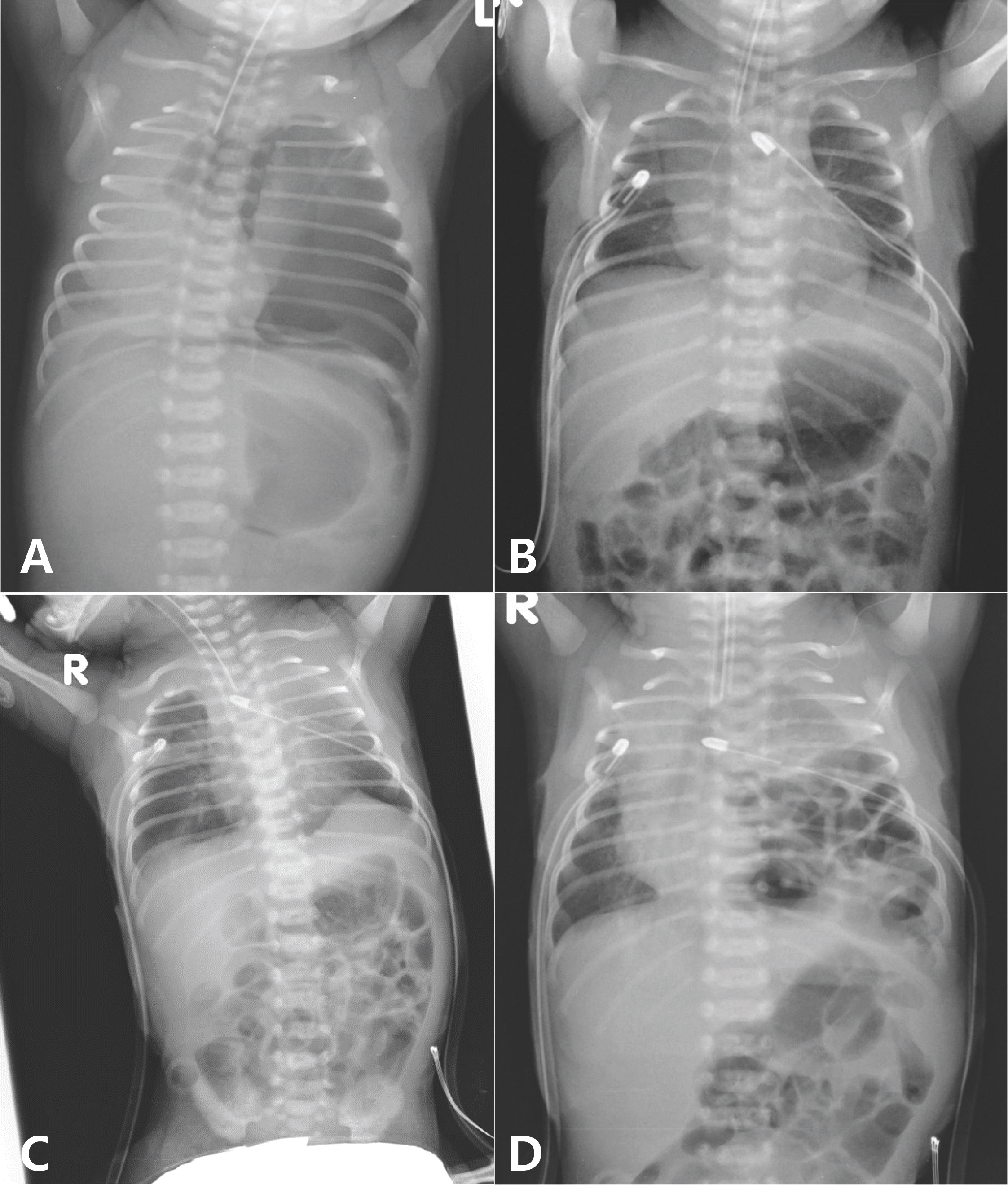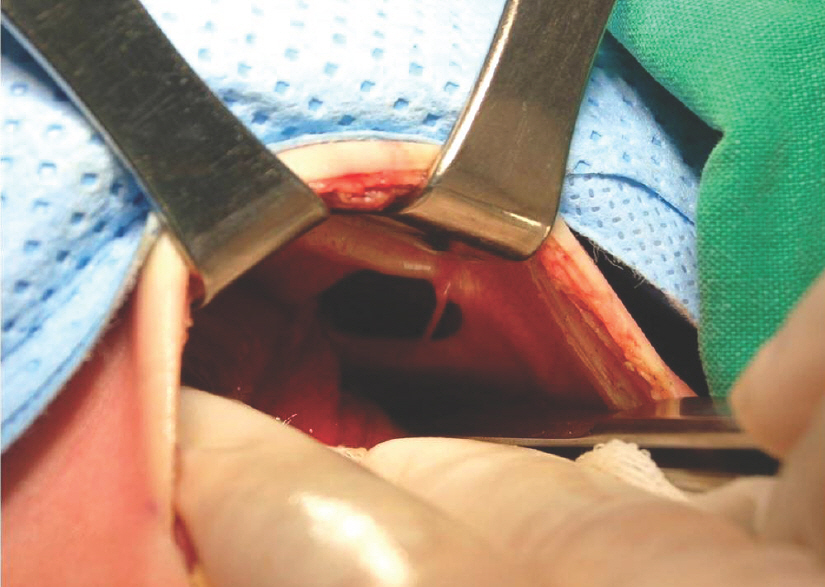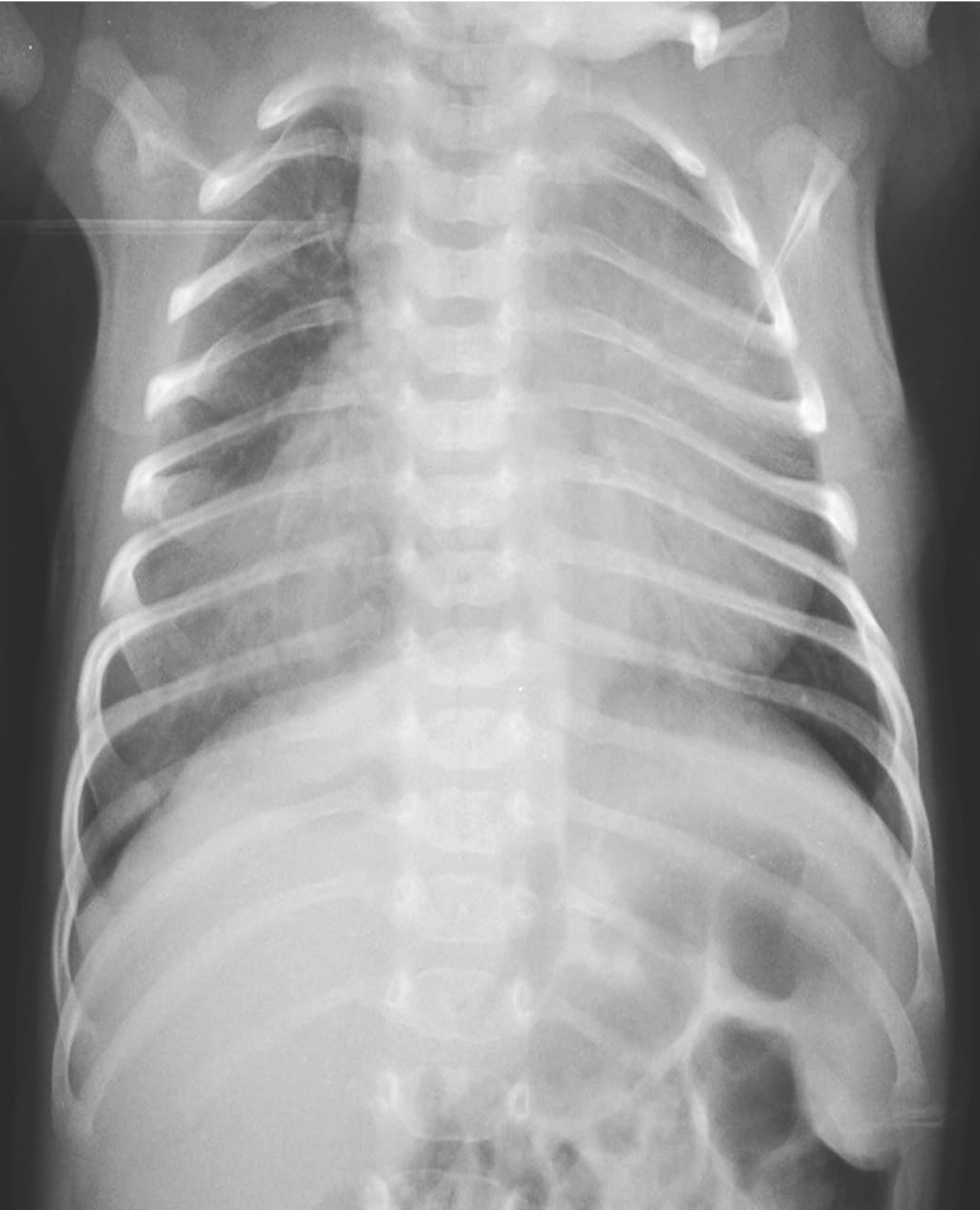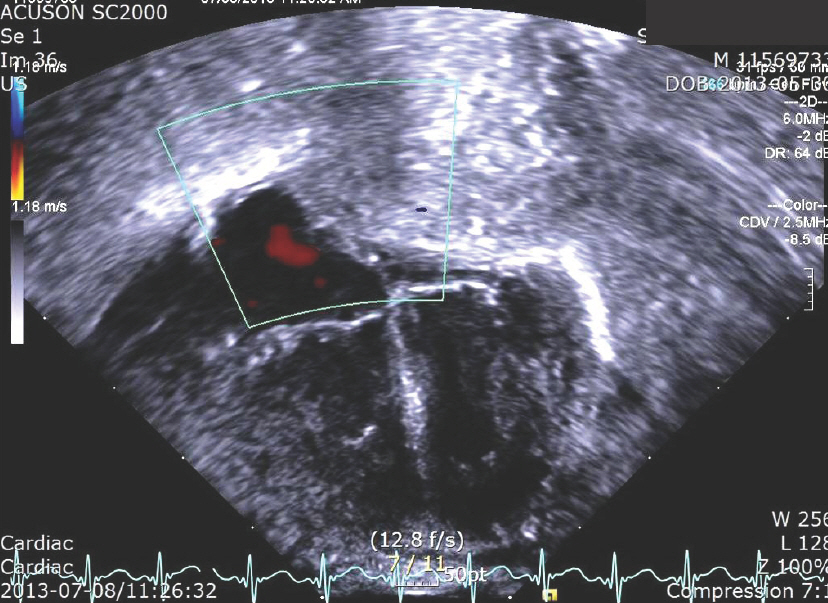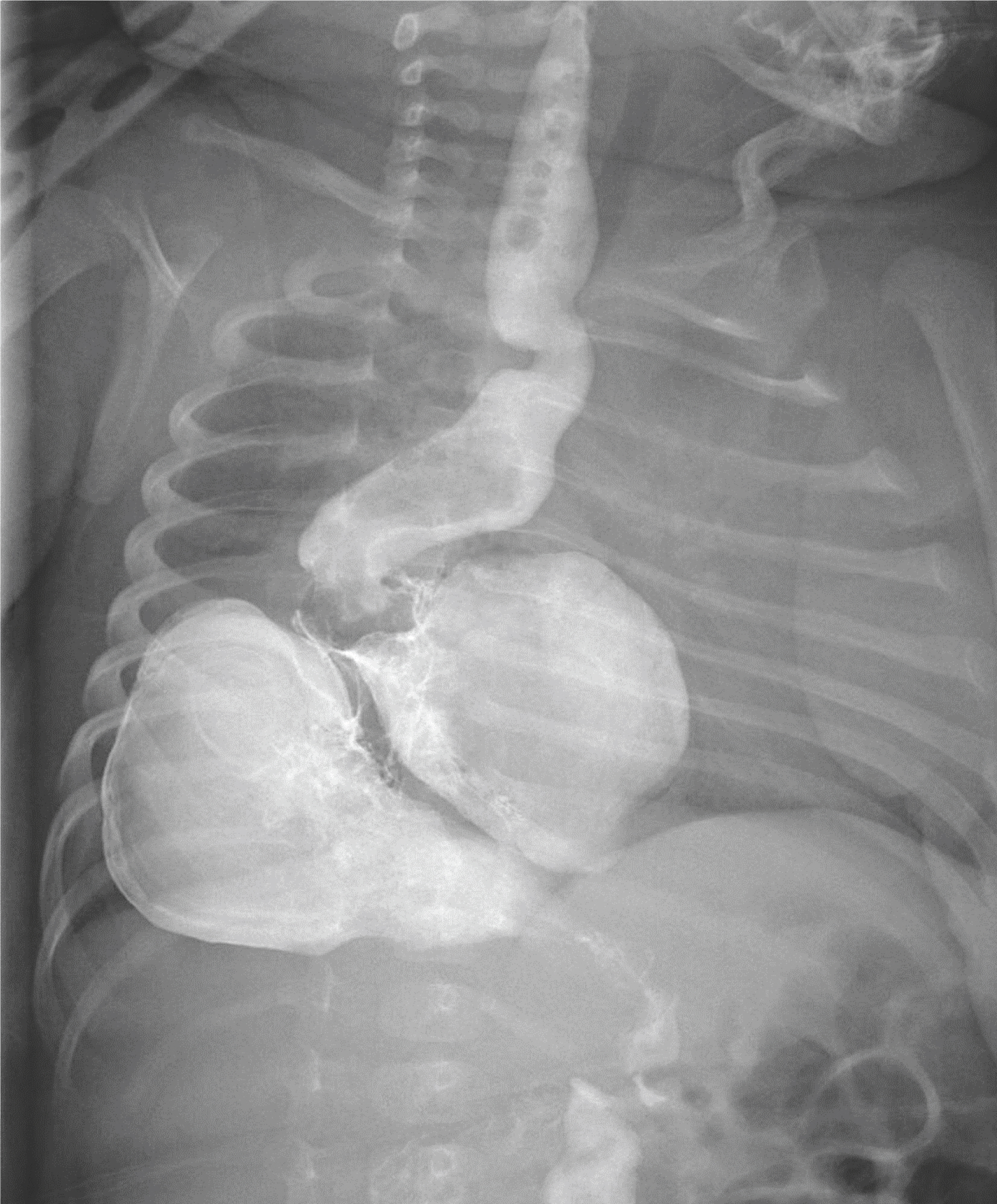Korean J Perinatol.
2015 Sep;26(3):237-244. 10.14734/kjp.2015.26.3.237.
Two Cases of Congenital Diaphragmatic Hernia Manifestated with Atypical Symptoms in Newborn Infants
- Affiliations
-
- 1Department of Pediatrics, CHA Bundang Medical Center, CHA University, Seongnam, Korea. joneona@cha.ac.kr
- 2Department of Surgery, CHA Bundang Medical Center, CHA University, Seongnam, Korea.
- KMID: 2281228
- DOI: http://doi.org/10.14734/kjp.2015.26.3.237
Abstract
- Most of the congenital diaphragmatic hernia (CDH) cases are diagnosed at prenatal period or immediately after birth with severe respiratory symptom. The classic triad, which is respiratory distress, apparent dextrocardia and a scaphoid abdomen, is usually seen in this period. Several case reports have described older infants and children with a wide spectrum of symptoms of CDH, whereas extremely few cases were reported in neonatal period except classic triad such as straungulation of the bowel. These atypical manifestations can lead physician to delayed diagnosis. We report two cases of CDH newborns. First case was diagnosed with pneumoperitoneum following tension pneumothorax, transient diaphragm eventration on 5 days after birth. The other case was diagnosed with failure to thrive and mediastinal mass on 30 days after birth. These cases suggest physicians to consider CDH in late newborn period with pneumoperitoneum following tension pneumothorax, transient diaphragm eventration, failure to thrive, and mediastinal mass.
Keyword
MeSH Terms
Figure
Reference
-
References
1. Song JE, Kwon OK, Kim YH, Lee HR. A case of late presenting congenital diaphragmatic hernia. Korean J Pediatr Gastroenterol Nutr. 2009; 12:246–50.
Article2. Gatea HK, T.Al-Gailani F, Abulhab RJ. Congenital diaphragmatic hernia: prevalence and management. Fac Med Baghdad. 2010; 52:380–4.3. Yap KH, Jones M. Late presentation of congenital diaphragmatic hernia after a diagnostic laparoscopic surgery (a case report). J Cardiothorac Surg. 2013; 8:8.
Article4. Tovar JA. Congenital diaphragmatic hernia. Orphanet J Rare Dis. 2012; 7:1.
Article5. Vega MT, Maldonado RH, Vega GT, Vega AT, Liévano EA, Velázquez PM. Late-onset congenital diaphragmatic hernia: a case report. Int J Sur Case Rep. 2013; 4:952–4.
Article6. Byun JM, Kim YN, Jeong DH, Lee KB, Sung MS, Kim KT, et al. A case of congenital right diaphragmatic eventration. Korean J Perinatol. 2009; 20:254–9.7. Kotecha S, Barbato A, Bush A, Claus F, Davenport M, Delacourt C, et al. Congenital diaphragmatic hernia. Eur Respir J. 2012; 39:820–9.
Article8. Lemos SPP, Lemos PVRB, Coelho NALR, de Abrêu DM, Feitosa LBR. Congenital diaphragmatic hernia with delayed diagnosis: report of two cases. Case RMports in Clinical Medicine. 2015; 4:114.
Article9. Bianchi E, Mancini P, De Vito S, Pompili E, Taurone S, Guerrisi I, et al. Congenital asymptomatic diaphragmatic hernias in adults: a case series. J Med Case Rep. 2013; 7:125.
Article10. Singh TC, Singh CG, Lamare KN, Babitha N, Kharnaior A. Congenital diaphragmatic hernia in adult presenting with obstruction: a rare case. International Journal of Scientific Study. 2015; 2:142–5.11. Baerg J, Kanthimathinathan V, Gollin G. Late-presenting congenital diaphragmatic hernia: diagnostic pitfalls and outcome. Hernia. 2012; 16:461–6.
Article12. Baglaj M. Late-presenting congenital diaphragmatic hernia in children: a clinical spectrum. Pediatr Surg Int. 2004; 20:658–69.13. Hamid KS, Rai SS, Rodriguez JA. Symptomatic Bochdalek hernia in an adult. JSLS. 2010; 14:279.
Article14. Josephsen JB, Klinkner DB, Kumar T, Al-Hosni M. Strangulated bowel as an unusual complication of neonatal congenital diaphragmatic hernia: a case report and literature review. J Pediatr Surg. 2013; 48:866–8.15. Starshak RJ, Sty JR. Diaphragmatic defects with gastric volvulus in the neonate. Wis Med J. 1983; 82:28–31.16. Esposito C, Settimi A, Centonze A, Savanelli A, Ascione G, De Marco M, et al. Bochdaleck diaphragmatic hernia, complicated by an antenatal gastric perforation, presenting as a pneumothorax and a perforative peritonitis. Pediatr Surg Int. 2008; 24:365–9.
Article17. Cserni T, Polonkai E, Torok O, Nagy A, Pataki I, Long AM, et al. In utero incarceration of congenital diaphragmatic hernia. J Pediatr Surg. 2011; 46:551–3.
Article18. Khemakhem R, Haggui B, Rahay H, Nouira F, Charieg A, Ghorbel S, et al. Congenital diaphragmatic hernia in neonate: a retrospective study about 28 observations. Afr J Paediatr Surg. 2012; 9:217–22.
Article19. Akoglu H, Coban E, Guneysel O. Tension pneumoperitoneum complicated with tension pneumothorax in a patient with diaphragmatic eventration. BMJ Case Rep BMJ Case Reports. 2012. 10. .1136/bcr.01.2012.5512.
Article20. Ackerman KG, Vargas SO, Wilson JA, Jennings RW, Kozakewich HP, Pober BR. Congenital diaphragmatic defects: proposal for a new classification based on observations in 234 patients. Pediatr Dev Pathol. 2012; 15:265–74.
Article
- Full Text Links
- Actions
-
Cited
- CITED
-
- Close
- Share
- Similar articles
-
- Giant Meckel's Diverticulum Associated with a Congenital Diaphragmatic Hernia
- Congenital diaphragmatic Hernia Associated with Hypoplasia of the Lung
- Unilateral Congenital Diaphragmatic Eventration Mimicking Congenital Diaphragmatic Hernia
- Clinical Study of Congenital Diaphragmatic Diseases in Neonates and Infants
- A Case of Sliding Hiatal Hernia associated with Bochdalek Hernia Repair

